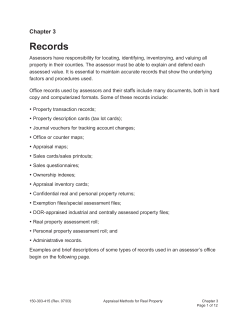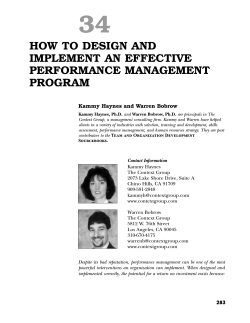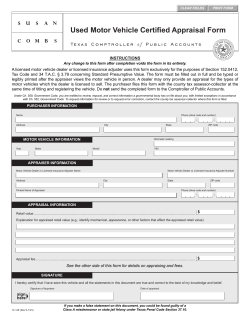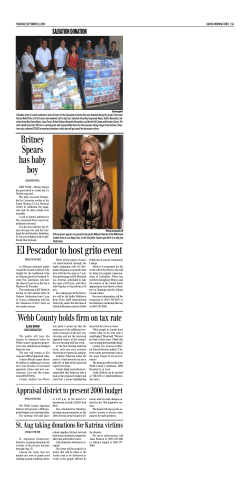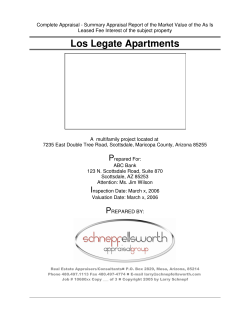
How to write more effective appraisals for the Forest Legacy Program
How to write more effective appraisals for the Forest Legacy Program Observations from Forest Service review appraisers on common weaknesses, deficiencies and omissions DISCLAIMER • This discussion will be conversational and general. • There will be opportunities for Q &A at breaks in the presentation. (You may want to print out the presentation for reference.) • It is NOT intended to replace a “Yellow Book” course sponsored by a professional organization. • This is NOT meant to replace a Pre-Work Meeting for a specific project, or subsequent interaction with a Forest Service reviewer for a specific project, since the facts and circumstances of each appraisal need to be taken into consideration for application of the “Yellow Book”. Overview: Role of Appraiser & Reviewer • The main purpose of USPAP is to preserve and promote the public trust in the appraisal profession. • Both appraiser and reviewer are governed by USPAP. • Role of Forest Service reviewer is to protect public funds, and to insure public money is spent appropriately for the public good. • Role of appraiser is to provide a creditable, reliable appraisal. • The appraiser and reviewer should be working toward a shared goal. Forest Service Oversight Process • Forest Service Reviewer conducts the first examination of appraisals for compliance with UASFLA and USPAP, which result in approval or disapproval. • Appraisals (and Appraisal Reviews) may also be examined in any one (or all) of a series of subsequent quality control audits, which include: • Forest Service Valuation Team Reviews • Forest Legacy Quality Assurance Inspections • Office of the Inspector General Quality Control Audits • Requests for revisions may be to clarify issues for all potential readers, and insure that appraisals are “selfcontained” documents. Objective: • To highlight areas of appraisals which often are not in compliance with UASFLA. • To highlight areas of appraisals which are often not in compliance with USPAP. • To highlight areas of appraisals which are often inadequately discussed or inadequately supported. Definition of Appraisal • An appraisal is an act or process of developing an opinion of value. • An appraisal report is the means of communicating the appraisal. • The following comments and observations apply to both the process of developing the opinion of value and to the communication of that process in the written report. Standards for FLP Appraisals • Uniform Standards for Federal Land Acquisitions (UASFLA) or “Yellow Book” is required. • Uniform Standards for Professional Appraisal Practice (USPAP) by the Appraisal Foundation is required. (Please reference the edition of USPAP referred to in the appraisal). • DO NOT prepare the appraisal to conform to IRS regulations for charitable contributions. • DO NOT prepare the appraisal to conform to State requirements. Interests (or Estate) Appraised • The estate to be appraised is the “as is” estate (or interest), which can be conveyed by the property owner as of the effective date of value. • The “as is” estate is seldom “fee simple interest”. • It should be identified as “all rights, title, and interest to the property vested in XYZ, L.L.C as recorded in Deed Book 135, Page 2514, of the public records of Boondoggle County, subject to the following easements, encumbrances, restrictions: (List encumbrances)”. Interests Appraised cont. • In order to know what the “as is” interests are, a complete title report (and possibly a survey) must be provided to the appraiser. • Easements, encumbrances, restrictions, and outstanding rights must be described, and the appraisal must report their impact on value. • Appraising the “as is” interests or estate held by the property owner involves giving consideration to encumbrances, restrictions, or outstanding rights in all appropriate approaches to value. • Refer to UASFLA A-2, A-7, A-11, A-20 and other references. Certification • Please refer to the UASFLA Section A-4 for a list of required statements. • As of January 2010, USPAP will also require a statement as to whether the appraiser had any involvement with the property in the previous 3 years and a description of that involvement. • FLP “Qualified” Appraisers: Only persons who have taken the “Yellow Book” class and are “qualified” under Forest Legacy Implementation Guidelines may sign the report and certification as “appraiser of record”. • Note: FLP requirements for “qualified appraisers” are not the same as USPAP “competency” requirements. The State must determine whether an appraiser meets FLP requirements for “qualified” appraisers. USPAP directs the appraiser to make a self evaluation for competency. Important Dates USPAP SR2-2(a)(vi) A prominent disclosure of these dates on cover, letter of transmittal, and/or executive summary is requested. • Effective Date of the Appraisal (effective date of value) • Date of Report • Date of Inspection General Assumptions and Limiting Conditions, UASFLA A-7. • This takes the 1st place prize for not complying with the “Yellow Book”. Please re-read UASFLA, Section A-7. • Omit disclaimers such as “Unless otherwise stated in the report…”, etc. • Omit “boilerplate and inappropriate or irrelevant assumptions. • Omit assumptions or limiting conditions which undermine the credibility of the opinions of value provided in the appraisal. • DO INCLUDE: interests appraised, encumbrances, encumbrances, restrictions, and outstanding rights, etc. Describe and include comment regarding impact on value. Extraordinary Assumptions and Hypothetical Conditions • Forest Service reviewer should provide in writing in the Task Assignment Summary (written appraisal instructions). • Do not include any Extraordinary Assumptions or Hypothetical Conditions without prior approval from the Forest Service reviewer. • Include in the Letter of Transmittal, Executive Summary, Certification, etc. • Valuation of a remainder parcel (“after”) requires the Hypothetical Condition that the proposed conservation easement is in place as of the effective date of value. Oil, Gas and Mineral Rights • OGM Rights may be determined from the title report in most instances. • A statement as to whether there are, or are not, any outstanding OGM RIGHTS is required. (If there are outstanding OGM Rights, reference the Deed Book, Page). (For Forest Legacy Projects, specific instructions may be issued regarding these rights.) • A discussion as to the impact on value of any outstanding OGM rights is required. • Task Assignment Summary (written appraisal instructions) will attempt to identify issues prior to the appraiser bidding on a project. This is a significant issue which impacts the eligibility of a property for Forest Legacy funding, and often requires special appraisal instructions. Please contact the Forest Service review appraiser with questions. Oil, Gas, and Mineral Assets • Some Forest Legacy Projects may be located in areas where oil, natural gas, coal, commercially viable sand and gravel, or other mineral assets are commonly found. • Sub-consultant reports may be required for some projects. (Refer to UASFLA, B-13). • It is relevant to report in the appraisal whether the property being appraised is located in an area known to have OGM or sand/gravel assets and how that impacts the opinion of value. • If there is reason to expect OGM assets to have an impact value, consult the Forest Service review appraiser. • Task Assignment Summary (written appraisal instructions) will attempt to identify issues prior to the appraiser bidding on a project. Clarification regarding sub-consultant reports will be provided. Oil, Gas, and Mineral Rights and Assets under FLP • The Forest Legacy Program has eligibility requirements for OGM rights and assets. • The Forest Service Reviewer and Forest Legacy Specialist will partner with the State and/or the Non-Profit Agency Partners to provide written appraisal instructions for each specific appraisal in the Task Assignment. 10 Year Ownership History See UASFLA Section A-13e for the minimum required information. • Recent sales should be verified and rigorously analyzed for relevance to the current appraisal. • Many sales are reported to be “bargain sales”. Many appraisers accept this with little or no analysis. Recent sales should be verified with both the buyer, seller, and broker. The marketing of the property prior to the recent sale should be considered and reported. • Acceptance of a “bargain sale” verification should be based upon a rigorous analysis and good support. The relevance of the recent sale for the current valuation should be discussed in the appraisal. • At minimum, the last sale information must be provided even if it predates the 10 year period. 10 Year Ownership History cont. • • • • • • • • • • • • Grantor Grantee Date of Sale Instrument (Warranty deed, quit claim deed, etc.) Recording (Deed book, page) Sale Price Description of the Property Sold (Size, timber, interests or estate) Verification (Name, relationship to transaction) Analysis Arm’s Length? Market Price? Relevance for current appraisal? Under Contract, Listed for Sale, Marketed for Sale USPAP SR 1-5: Requires describing and analyzing all contracts for sale, options, listings, or marketing of the property. • The verification process should be rigorous, and may require verification with the buyer, seller, and marketing agent. • Describe marketing (how marketed, listed, days on market, asking price, etc. • A claim of a “bargain sale” should not be accepted without rigorous verification and support that the price is “below market”. • Relevance for current appraisal? Zoning and Land Use • Does the zoning/land use discussion also consider the following: – Access: land development regulations regarding access (public road, easement, landlocked) and infrastructure requirements? – Utilities: requirements for septic systems, wells, etc.? Are public utilities required for maximum density? • Does this discussion include a conclusion as to the specific permitted uses, density, and infrastructure requirements for those uses/densities? • If the appraisal concludes that there is a reasonable probability of a change in zoning or land use, adequate support must be provided as well as the name and phone number of the planning staff with whom this was discussed. Access The appraisal should provide a clear and comprehensive description of the legal and physical access to the subject property and for the comparable sales included in the appraisal. • Legal access may be by public road, easement (give Deed Book, Page if recorded), or a property may have no legal access. • Physical access may be by paved, gravel, dirt track or seasonal logging road? It may be a one lane path or multilane arterial road with median? Tell the reader whether you can drive your Lexus to get to the property, or must you take a pack mule? • Access often has a significant impact on legally permitted uses, highest and best use, and property values. Access (legal and physical) should also be discussed and considered in these sections of the appraisal. Larger Parcel • Forest Service Reviewer will attempt to provide a description of the ownership, the acquisition, and a preliminary opinion of the larger parcel in the Task Assignment Summary. • It is the responsibility of the appraiser to include a complete discussion of the larger parcel with respect to the tests of unity of ownership, unity of use (highest and best use), and contiguity. • The larger parcel must at least include the proposed acquisition; however, the opinion of what constitutes the larger parcel is made without reference to the acquisition. • Please contact the review appraiser to discuss the larger parcel if the opinion is different from the preliminary larger parcel in the Task Assignment. Marketability and Market Conditions (Time Adjustment) Analysis An analysis of supply and demand, user demand, market share appropriate to the appraisal problem and property type should be included. Good Support: – Sale/Resale – Paired Sales – Median Price trends – Supply/demand – Marketing time (days on market, etc.) – Multiple Listing Service (MLS) data – Economic data (employment, housing starts, foreclosures, demographics, population trends, per capita income, etc.) Less Reliable Support: – Tax Assessments (historical data, political factors) – Interviews Highest and Best Use • Vacant: Highest and best use of the land as (if) vacant should be a separate analysis (legal, physical, feasible, max. productive) with a clearly stated conclusion. • As Improved: Highest and best use of the property as improved should be a separate analysis (legal, physical, feasible, max. productive) with a clearly stated conclusion. If improvements have no contributory value, or if they are interim uses, this is the place to discuss contributory value. Highest and Best Use cont. • The highest and best use discussion is most clearly presented if discussing the legally permissible, physically possible, financially feasible, and maximally productive uses as separate sections. • Include a clear conclusion of highest and best use, or alternate uses. • Don’t generalize (ex. “residential development”). • Be specific (ex. Approximately 8 to 10 rural residential lots of 5 to 10 acres in the $65,000 to $95,000 retail price range with development expected within the next 5 years). Government and Quasi-Governmental Sales • Please refer to UASFLA D-9 regarding use of government (or quasi-governmental) sales. Reliance upon government sales requires documentation that the requirements have been met. • It is often difficult to meet the extraordinary verification requirements; it may be most appropriate to include these sales for informational purposes, but not rely upon them for concluding to an opinion of value. • Please discuss this with the Forest Service review appraiser if you have questions regarding the appropriateness of a government sale. Quantitative Adjustments to Comparable Sales • Quantitative adjustments (dollar or percentage adjustments) require quantitative support from the market such as: – Sale/resale – Paired sales analysis – Statistical trends – Regression analysis • Support for a quantitative adjustment must be demonstrated by a quantitative analysis. • Forest Service Reviewer is not permitted to approve appraisals in which the opinion of value is produced by analyses with unsupported quantitative adjustments. Qualitative Adjustments • Qualitative adjustments may be appropriate if quantitative adjustments cannot be supported by market derived data. • The property being appraised should be bracketed by sales ranked superior and inferior (or equal) in order establish an upper and lower limit to value. • Qualitative analyses require sufficient discussion of the features of comparison and explanations of why they are superior, inferior, or comparable to the property being appraised. The overall ranking of each comparable should be discussed and explained. Sequence of Adjustments • The Appraisal of Real Estate, 13th Edition, Chapter 13 recommends that “transactional adjustments” be applied sequentially before “property adjustments”. However, there is no magic formula for the sequence of adjustments. • Typically, most quantitative adjustments are applied in sequence before qualitative adjustments, but the appraiser is advised to check the selected sequence to insure that unintended distortions do not occur as a result of the sequence. Conservation Easement Encumbered, or “Less Than Fee”, Comparable Sales • DO NOT apply a simple “discount off of the fee simple land value” for interests conveyed with the encumbered area. • “Interests Conveyed” adjustments may refer to the ratio of encumbered and unencumbered acres or to the property interests retained by the property owner. • It may be appropriate to apply separate “Highest and Best Use” adjustments to encumbered areas and unencumbered areas, or to apply a single adjustment to the property as a whole. • Clarify for the reader what you mean by “interests conveyed” and “highest and best use”. Avoid omitting or double counting aspects of these features of comparison. • Let the data speak. There is more than one way to skin this cat. • Show calculations for quantitative adjustments. Before and After Appraisals for Conservation Easements • A “Before and After” appraisal is basically 2 separate appraisals. • Each appraisal (ie, the “before” appraisal and the “after” appraisal) requires separate descriptions of the property, highest and best use, approaches to value, and final opinions of value. Please refer to UASFLA (Yellow Book) for format. • Loss of “Development Rights” may or may not result in a significant change in value. Any claim that the loss of development rights will impact an “after” value must be based upon adequate support for the “before” highest and best use. Support from the market is required (demographics, projections of supply/demand, etc.). Development Approach, Land Residual Technique UASFLA, B-8: Due to the sensitivity of this approach to inputs and assumptions, it should be used with caution, and preferably as support for the direct sales comparison approach or as a test of feasibility in the highest and best use analysis. Market derived Support and Analysis must be provided for: • Supply/demand/market share/absorption/lag time • Pricing • Expenses, marketing and development costs, etc. • Profit • Discount rate The Forest Service Review Appraiser is not permitted to approve appraisals which do not provide adequate market derived support and analysis. Timberland Appraisals • UASFLA, Section B-13 Unit Rule: It is generally inappropriate to add the stumpage value of timber to the value of the land to arrive at an opinion of value for a timber tract. • It is important to consider the highest and best use for transition land. • The Task Assignment will state whether an Income Approach is required. • The Task Assignment will identify whether a timber cruise will be provided, whether a timber inventory will be provided, and who will be responsible for the cost. The appraiser may be asked to participate in these decisions. • Income approach must be based upon market derived support for stumpage values, expenses, discount rates. • Wood Supply Agreements, recreational leases, and other actual encumbrances must be considered and reflected in the valuation analysis. Final Reconciliation of Values • Before Value of Larger Parcel • After Value of Remainder Parcel • Difference • The difference between the before value and the after value is the “difference”, not the “value of the conservation easement”. The difference also reflects consideration of any enhancement or diminution in value to the remainder. Comparable Sale Write Ups • Location: Comparable sale write ups should include a narrative location description detailed enough to allow a reader to locate the property during a field inspection (ex. North side of Road X, approx. 2 miles west of Route Y, in ABC County, Wisconsin). • Verification: By whom (name of appraiser), with whom (name of person verifying sale), relationship to transaction (grantor, grantee, broker, etc.), and date of verification. • All relevant data: Access (legal and physical), upland/wetland areas, topography, zoning, highest and best use, gross and forested acres, gross timber value, etc. • All relevant units of comparison: For example: Sale price per gross acre, per developable acre, and per unit and density (if residential). Sale Price per gross acre, gross timber value per acre, etc. Information To Be Provided To The Appraiser by the Client • Title Report (a complete title report is necessary for the correct estate to be appraised) • Current Contract, listing information, marketing information • Survey or “Appraisal Maps” (larger parcel/ownership, proposed acquisition and remainder) • Land Areas (gross land area, upland area, forested/operable area, etc. as appropriate for the property type) • Conservation Easement • Written Appraisal Instructions (Task assignment, etc.) • If the appraiser is not provided with this information, please contact me to discuss as it may be necessary to include Extraordinary Assumptions in the appraisal. Report Format UASFLA AND USPAP do not address format issues. However, appraisal reports are more “user friendly” if they are/have: – Single sided (not double sided) pages; – Bound with “comb” binders or three ring binders to allow copying or inserting revised pages (permanent bindings are not user friendly); – Maps and exhibits in color; – Signed final copies (unsigned “draft” appraisals are not reviewed); – A complete electronic version in PDF format of the final approved appraisal is appreciated, but not yet required. Read the Yellow Book • Many common deficiencies can be remedied by the appraiser by referring to the Yellow Book to check the requirements for each section. • The Yellow Book provides an outline and guide for the minimum information which should be included in most sections of the appraisal. • Appraisal practice and USPAP change over time, and the Yellow Book will not address everything which must be considered and included. Be Your Own Reviewer • Please proof read your own report. • Check the math. • Check Excel spreadsheets with a handheld calculator. (You would be amazed!) • Spending an extra hour before the Forest Service reviewer reads the report can save many more hours of work later. (And paper. Think of the trees!) UASFLA AND USPAP • Uniform Standards for Federal Land Acquisitions (UASFLA), Interagency Land Acquisition Conference 2000: A copy may be obtained from the Appraisal Institute, American Farm Managers and Rural Appraisers, or the Department of Justice (website). • Uniform Standards of Professional Appraisal Practice from the Appraisal Foundation: A copy may be obtained from the Appraisal Foundation or professional appraisal organizations referenced above. • This presentation is not a substitute for an accredited “Yellow Book” class sponsored by the Appraisal Institute or the American Society of Farm Managers and Rural Appraisers. Our Goal • To work with the most well qualified appraisers. • To be a client of choice. Forest Service Review Appraiser Contacts • Please contact the Forest Service Review Appraiser with questions. • Please contact the Forest Service Review Appraiser with suggestions. • The Forest Legacy Program is best served by us, the Forest Service review appraisers and the contract fee appraisers, if we communicate throughout the appraisal process. Contact Information Susan T. Waller, MAI Senior Review Appraiser U.S. Forest Service 231 North Main Street Rutland, VT 05701 (802) 747-6761 Email: susanwaller@fs.fed.us
© Copyright 2025


